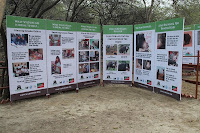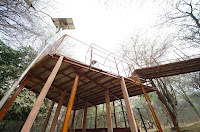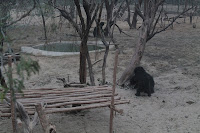This is an update on the four bears rescued from the Indo-Nepal border in February of this year. For the original news piece on the rescue, please click here to read it on our website.
Michael Oreo
 |
Michael Oreo loves the fresh fruit basket
delivered to his den every morning! |
Michael
Oreo (formerly known as Oreo, but renamed Michael Oreo in honour of one of our
biggest and best supporters) is three years old, and was rescued from the
Nepalese border by Wildlife SOS in February this year. He weighed 86kg, and has
put on a further 8kg since his arrival at International Animal Rescue’s Agra Bear
Sanctuary. His keeper says the bear is a big fan of porridge and fruit, and
particularly enjoys the sugarcane enrichment! He also enjoys playing with the
ball in his den.
He was
recently introduced to Goldie, one of the other bears seized in the raid. They
get on really well, and enjoy playing together. Michael Oreo loves playing with
water, and splashes it out of his drinking tub at every opportunity! He is
surprisingly bold around his keeper, and does not seem worried by strangers.
This
lovely bear is undergoing treatment for a mild respiratory tract infection as
diagnosed from his initial chest radiograph and blood analysis results. Sadly
his dental exam revealed that all his canine and incisor teeth are missing. This
will be closely monitored by his keeper to ensure that he can eat properly and
that any infection (as a result of the crude way his teeth were knocked out by
poachers) is caught and treated swiftly.
Truffles
 |
Truffles waits by the door of his den hoping
for a second breakfast! |
Truffles
is a mischievous and affectionate bear, aged around fifteen months old. He is
still in quarantine after his dramatic rescue from the Nepalese border in
February, along with three others.
Touchingly,
Truffles was so ecstatic when the coarse rope - which had been forced through
his soft muzzle by the poachers - was cut away, that he rubbed his nose along
the ground before dashing outside into his run, running round and round as if
to celebrate his freedom.
His keeper
describes him as a happy-go-lucky bear, who greets him with “bear hugs” and
nudges when he arrives each morning with breakfast. He is a bear who enjoys his
food, and has grown very fond of the keeper who supplies it!
Fortunately,
Truffles’ dental examination did not reveal any serious issues, and the
visiting dental team from the UK (blog post to follow!) gave them a thorough
clean. However, it was clear that there had been an attempt to break his teeth
when he was very young, as his teeth have grown through with the tips broken
off. This does not seem to have caused him any problems, though.
Truffles’
love of food has resulted in a weight gain of 5kg, putting him at 67kg. He
loves porridge so much he puts his whole face into his bowl rather comically to
make sure he doesn’t miss a single precious oat! He likes to play with fruit before
munching it, and like, Michael Oreo, enjoys splashing in his water tub,
treating it like a miniature swimming pool!
Unlike
Michael Oreo, Truffles is quite wary of strangers, and prefers them to keep
their distance.
Kandi
 |
| Kandi is doing well in quarantine |
Kandi
is believed to be around two years old, and was rescued alongside Michael Oreo,
Truffles and Goldie in February. He is quite small for his age and has lots of
growing to do, weighing only around 60kg. He is a friendly little bear, and
enjoys lots of attention, making him very popular with the keepers.
His appetite
is quite small, and he will often not finish his evening meal of porridge, but
tucks into the fruit with gusto. He loves to splash around with his water, and
when the keepers hose his den down, he tries to wrestle the hosepipe away from
them to spray the water on himself!
Kandi
has a painful infected injury to one of his claws, but it is responding well to
treatment. It hasn’t dampened Kandi’s spirits, and he seems to be enjoying his temporary
stay in quarantine.
Goldie
 |
Goldie is blind, and suffered terribly at the hands
of his captors |
Goldie
has the saddest story of the four bears rescued in February. Aged just five
years old, he is already blind in both eyes. He weighed 98kg on arrival, which
for a male bear of his age is a little underweight. He displayed signs of tremendous
hunger, yet he was not eating properly. Consequently, one of the on-site vets
sedated him and did a full medical examination of him.
Thanks
to this diligence, it was discovered that poor Goldie was suffering from a serious
infection in a rotten upper canine tooth. His Kalendar “master” has been
particularly brutal and careless towards Goldie, and he has probably suffered from
unbelievable pain throughout his life. Fortunately, the dental team from the UK
were in Agra in April, and removed this tooth. Goldie is now enjoying his diet
of porridge and fruits, and has put on weight since the successful operation.
It is
not yet known if his sight will be able to be restored or if the damage done to
his eyes (probably by the rope through his nose rubbing on his optic nerve) is
permanent. What we do know is that if it is
possible to restore his sight, then our fantastic vet team will do it!
The rehabilitation and lifelong care of these four sloth bears will be expensive. If you can, please visit our website to make a donation. If you are unable to make a financial contribution, please share this post on Facebook, Twitter, via email and any other way you can think of to help raise awareness of the work we are doing to protect India's bears!

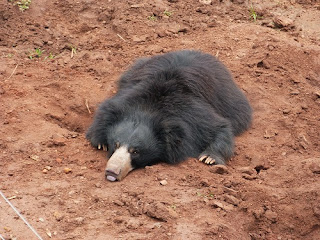



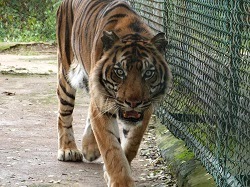











.jpg)
